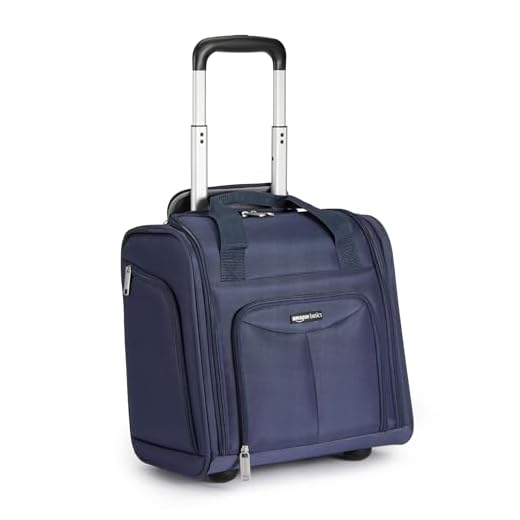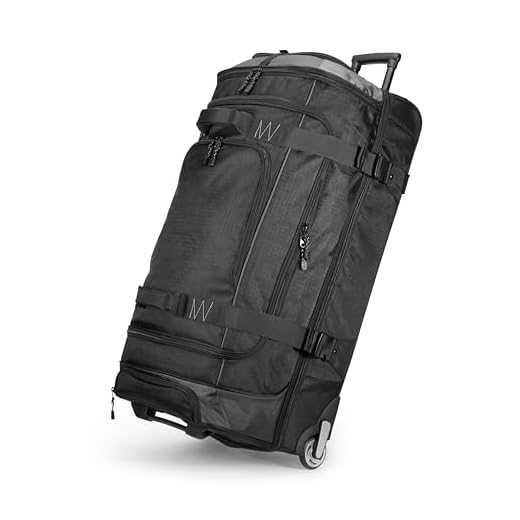






Choosing a bag that weighs under 7 pounds is advisable for effortless travel, ensuring ease in maneuverability and convenience during journey transitions. This benchmark allows for additional belongings without exceeding airline regulations, enhancing travel compliance.
Consider options made from durable materials such as polycarbonate or ballistic nylon, which typically keep the overall mass down while ensuring resilience. A quality bag under 5 pounds is optimal for those looking to maximize capacity without sacrificing mobility. This category often includes design features like high-capacity compartments to aid organization.
Airlines often specify restrictions around sizes and weights; hence, opting for a rolling suitcase or a versatile backpack can significantly improve your travel experience. By adhering to guidelines, you can seamlessly transition from check-in to boarding without the stress of extra fees or delays.
When selecting your next travel companion, prioritize bags that balance lightness with structure. This ensures long-lasting use and flexibility for various travel needs, making every trip smoother.
Understanding Industry Standards for Lightweight Luggage
Manufacturers typically classify bags weighing below 5.5 to 7.0 pounds (2.5 to 3.2 kg) as suitable for travelers seeking to minimize burden during transit. Major airlines often set maximum allowances at 50 pounds (22.7 kg) for checked items, so ensuring that your chosen piece remains under this threshold is vital.
Material Considerations
Quality materials such as ballistic nylon, polyester, or polycarbonate are preferred for constructing resilient yet lightweight carriers. The selection of materials greatly influences both durability and overall mass. Innovations in fabric technology now allow for exceptional strength without compromising on transportability.
Design Features
Optimal designs incorporate streamlined shapes, minimizing excess padding while ensuring essential compartments remain functional. Look for features like adjustable straps and removable wheels that contribute to versatility without adding unnecessary kilograms.
Common Weight Limits Across Airlines
Most carriers impose restrictions around 20 to 23 kg (44 to 50 lbs) for checked bags, while cabin baggage typically ranges from 7 to 10 kg (15 to 22 lbs). Notably, the regulations often differ significantly among airlines, requiring travelers to verify specific requirements prior to departure.
Airline-Specific Guidelines
For example, low-cost airlines like Ryanair and EasyJet may have stricter allowances, limiting cabin baggage weight and dimensions to ensure compliance. In contrast, premium carriers such as Emirates and British Airways usually provide higher limits, often complemented by more generous personal item allowances. Always consult airline websites for up-to-date policies.
Additional Tips for Smart Packing
Utilizing compression packs can help optimize space, making it easier to fit belongings within the stipulated weight limits. Moreover, selecting brands known for durability and lightweight features can enhance travel convenience. To discover quality options, explore the best luggage brands. If your adventure requires outdoor gear, consider the best umbrella base for windy area for added stability.
Investing in packing tools like the best pressure washer spray gun can make maintaining travel equipment easier while ensuring all items remain in top condition. Adhering to these guidelines will help maximize personal belongings without incurring excess baggage fees.
How to Choose Lightweight Luggage Within Your Weight Range
Prioritize understanding your specific requirements. Assess what items you typically carry during travels, including clothing, toiletries, and gadgets. Calculate their approximate total mass to have a clearer idea of how much room is available for the suitcase itself.
Material Matters
Select pieces made from robust yet lightweight materials. Polycarbonate and high-density nylon are excellent choices, providing durability while keeping mass down. Avoid heavy fabrics that could contribute unnecessary weight.
Design Features
Focus on design elements that enhance usability without adding bulk. Look for suitcases with telescoping handles, spinner wheels, and compression systems that optimize internal space. A well-designed interior layout can minimize the need for extra heavy bags.
Lastly, weigh your options before purchase. Utilize a scale to compare different products directly, ensuring that whatever you select fits comfortably within your preferred range. This strategy helps prevent surprises during check-in or boarding.
Comparing Materials: Impact on Luggage Weight
Choosing the right fabric significantly influences how much your travel gear will weigh. Materials like nylon and polyester are often favored for their durability and lightweight properties. For instance, high-denier nylon typically offers a better strength-to-weight ratio than lower-denier options.
Synthetic vs. Natural Fibers
Synthetic materials, such as polypropylene and high-density polyethylene, provide exceptional resistance to wear while remaining very light. In contrast, cotton canvas, while aesthetically pleasing and environmentally friendly, tends to be heavier and bulkier. This should be considered when planning an efficient carrying weight.
Structure and Design Effects
The design elements also play a role. A streamlined, minimalist structure reduces excess material and contributes to lower mass. Reinforced areas can enhance longevity without adding substantial bulk. Lay your options side by side to assess how construction impacts both functionality and portability.
Tips for Maximizing Packing Efficiency with Lightweight Options
Prioritize versatile clothing items that can be layered, reducing the number of pieces needed. Opt for travel-friendly garments like wrinkle-resistant fabrics to keep your outfit looking polished.
Smart Packing Techniques
- Utilize packing cubes to organize items and save space efficiently.
- Roll garments instead of folding to minimize wrinkles and increase capacity.
- Incorporate compression bags for bulkier items such as jackets.
Strategic Accessories
- Choose lightweight shoes that can serve multiple purposes, like sneakers for sightseeing and casual dinners.
- Include a multipurpose scarf, which can act as a blanket, a fashion accessory, or a warm layer.
- Limit electronics; opt for a multi-port charger to keep tech gear lightweight and manageable.
Consider prioritizing travel-sized toiletries or using solid versions to avoid excess weight. Limit bulky items and replace them with compact alternatives, such as quick-drying towels that fold easily. These strategies will enhance packing accuracy while maintaining room for all necessary belongings.
FAQ:
What is considered lightweight luggage in terms of weight?
Lightweight luggage typically refers to bags that weigh between 4 to 7 pounds (about 1.8 to 3.2 kilograms) when empty. Different airlines may have their own specific guidelines regarding luggage weight, so it’s advisable to check with your airline before traveling. The goal of lightweight luggage design is to allow travelers to maximize their packing capacity while minimizing the weight they need to carry, making it easier to transport and handle.
How much weight can I pack in lightweight luggage?
The weight limit for packing in lightweight luggage largely depends on the specific airline’s regulations and the overall weight allowance for baggage. Generally, most airlines allow checked baggage to weigh up to 50 pounds (about 23 kilograms) for economy class. Therefore, if your lightweight suitcase weighs around 5 pounds, you could pack up to 45 pounds of items inside. It’s wise to weigh your luggage before heading to the airport to avoid any additional fees for excess weight.
Are there benefits to using lightweight luggage when traveling?
Using lightweight luggage offers several advantages for travelers. First, it reduces the overall burden of carrying heavy bags, especially during long trips or when navigating through airport terminals. Lightweight luggage often features durable materials that can withstand travel wear and tear while keeping the overall weight low. Additionally, having a lighter bag may allow for easier handling, whether you’re lifting it into an overhead compartment or pulling it along. This can enhance your overall travel experience by making it more convenient and less stressful.
What features should I look for in lightweight luggage?
When selecting lightweight luggage, consider several important features. Look for materials such as high-quality nylon or polycarbonate, which provide strength without adding excess weight. Additionally, check for organizational compartments to help keep your belongings organized and easily accessible. Sturdy, smooth-rolling wheels and ergonomic handles can improve maneuverability and comfort. Also, consider the size and dimensions of the bag to ensure it meets airline regulations. Finally, a lightweight luggage with a warranty can provide peace of mind regarding its durability.







